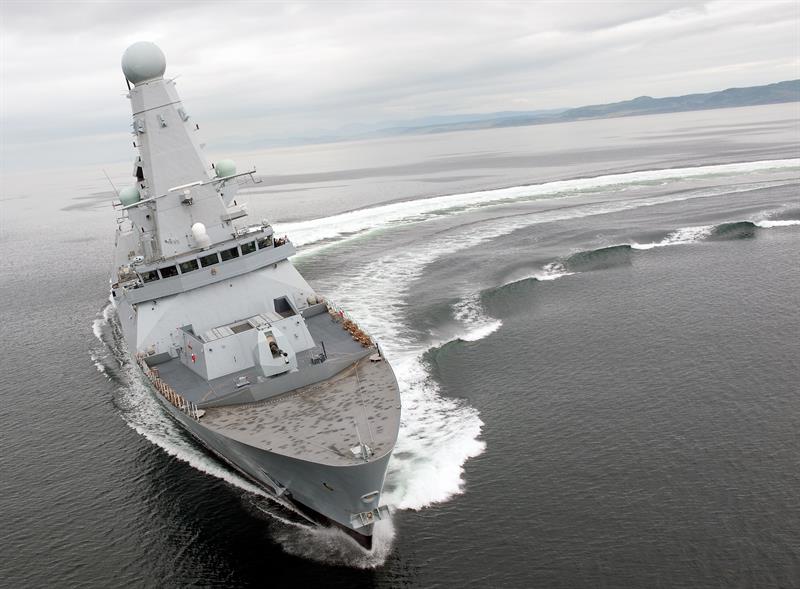In the UK, the Ministry of Defence’s (MoD) procurement activity now encompasses technology such as cloud and digital services, software and technology products, as well as more traditional military equipment.
The last Government’s Strategic Defence and Security Review, published in 2015, committed the UK to spending £178billion on new defence equipment from 2016 to 2026. The size of that budget and the complexity of those defence projects means the MoD is having to work more closely with key suppliers, whether traditional ones like Boeing, BAE Systems and Rolls-Royce, or with non-traditional suppliers in order to deliver its key equipment programmes.
“Large platforms, like the RAF’s Typhoon or the Navy’s new Queen Elizabeth aircraft carriers, are contributing to an increasingly data rich environment,” says Bede O’Neill, business development consultant with Plextek. “These platforms are supported by highly integrated and sophisticated systems.”
Mohammad Dabbah, a senior consultant engineer at Roke Manor Research, agrees and says that one of the biggest trends in the military space is the growing use of sophisticated sensor technology.
“Deployment is becoming cheaper and more widespread. As a result, a lot more data is being generated. How that data is processed and used will be crucial.”
The pressure to deliver projects faster is also growing and the MoD is turning in many cases to commercial off the shelf technologies (COTS) to augment more traditional systems.
“COTS components are certainly having an impact on designs and supply, but equipment still has to be robust, easy to use and sophisticated enough to get the job done,” says Lee Thompson, European marketing director, military, aerospace and space markets, for TTi. “In many cases, it’s still not an environment that is always suitable for commercial grade components.”
Cost always remains a key driver, according to Thompson, “But its importance varies from project to project. If the industry is responding to an immediate need in a combat situation, for example, it has to operate in a much shorter window and then the cost element is rarely taken into consideration.”
Innovation
Innovation in defence procurement is growing in importance and the MoD has said that it wants to encourage both more innovation and to attract new suppliers to the supply chain.
“Science and technology are converging rapidly,” says O’Neill. ”For example, Plextek has been involved with a number of innovative military research programmes, such as adaptive visual camouflage, robotic military vehicles and a body armour integrity system.”
 Bede O'Neill, business development consultant, Plextek
Bede O'Neill, business development consultant, Plextek
“Recently, there has been a dramatic change within senior military circles,” suggests Dabbah, “and there is now greater willingness to embrace technology such as autonomous vehicles, artificial intelligence and machine learning than was the case a few years ago.”
Wearable technology is one key area of development and is being used to monitor the health of troops and enable commanders to both monitor their troops’ location and to communicate and direct them in the field.
According to Paul Bandy, Aerco’s director of product management and procurement: “Many manufacturers are at the development stage with wearable technology, which needs to be lightweight, robust and compact.
Sensor technology is the key to the successful deployment of wearable devices and the IoT has been crucial in opening up the military to a broader range of applications and it will have an important role going forward.”
The dramatic growth of the IoT has encouraged the MoD to turn to consumer electronics technology for re-use in a military context. As a result, opportunities now exist for suppliers of all sizes, from established defence contractors to start-ups.
“Many technologies developed for the consumer market can be repurposed for military use and the MoD is turning to non-state actors to deliver the equipment it needs,” suggests O’Neill. “Our work on adaptive visual camouflage for military vehicles is a case in point.”
This project saw Plextek adapt e-paper technology, as used in the Kindle, to create large display panels for military vehicles. These can be updated rapidly to best match the surrounding backdrop making it a fully adaptive form of camouflage.
Sensors to monitor equipment and provide data are playing an important role, with the deployment of platforms to record data in real-time and provide self-diagnostic solutions to alert maintenance engineers when faults appear.
Plextek’s Body Armour Integrity System uses sensors to monitor the status of body armour plates continuously and to indicate whether the armour is safe to use or if it should be returned for x-ray analysis.
“Our system can detect when an impact occurs and whether the armour has been compromised,” explains O’Neill. “Currently, 100% of body armour plates are returned to the OEM for x-ray analysis, regardless of their condition. What this system does is to reduce that requirement, speed the assessment process and end the need to ship back all the armour for inspection by the OEM.”
“With more smart sensors being deployed, the military is looking to limit the data stream and wants to see more of the processing done locally,” explains Dabbah. “Future military conflicts will be extremely complex and the RF environment will be congested. Only the most important data will be passed back to the ‘controller’ or ‘analyst’, shortening the data decision cycle. Speeding the decision-making process and making it secure is going to be crucial if the military is to adapt to new situations.
“The military wants to make units as independent as possible, but able to provide the right data to the analyst so decisions can be made quickly. It’s about making the decision process easier.”
To better access technology, an Innovation Fund (worth £800million over 10 years) has been established in the UK to encourage collaboration between industry and academia and to target new providers.
The Defence and Security Accelerator, part of the Defence Science and Technology Laboratory, is focused on innovation. It funds the development of innovative ideas from suppliers and provides support through to potential application, whether for wearable technology, autonomous vehicles or projects involving artificial intelligence.
The Royal Navy’s STARTLE project is an example, with Roke integrating AI software into a maritime combat system demonstrator.
“STARTLE uses machine situational awareness software to monitor and evaluate potential threats continuously,” Dabbah explains. “The concept is that, by using AI, naval vessels will be able to detect and assess threats rapidly; continuous learning will mean that it will be able to remove any anomalies.
“The software has been designed to provide superior situational awareness in complex environments and will help the command team make more informed decisions. The software is intended to augment the operator’s situational awareness in what can be a very complex environment.”
According to Dabbah, this technology can be integrated into existing warship sensor suites. “Not only will it help to speed reactions, it will also help to support and justify actions taken.”
STARTLE is being integrated into the MoD’s Open Architecture Combat System, which is intended to show the utility of research ideas in a representative combat system in a realistic environment.
At a time when the very nature of conflict is evolving, the military is looking to invest heavily in the deployment and use of autonomous vehicles, which are seen as an important component in a modern military’s capability.
In the UK, the Royal Navy is already deploying drones to scan vessels for damage – inspections that would have taken many days can now be concluded in a matter of hours. Not only does this speed inspection, it requires fewer people and helps cut the costs of ownership as well as extending the lifespan of an asset.
 The Royal Navy's HMS Dauntless, a Type 45 air defence destroyer
The Royal Navy's HMS Dauntless, a Type 45 air defence destroyer
In time, the military is expected to embrace automated maintenance drones capable of spotting faults or identifying damage. Once it does, repairs could be undertaken remotely, without the control or oversight of an engineer.
Virtual reality is being used to train soldiers, as well as improve the way maintenance is carried out. Meanwhile, armed forces are beginning to embrace 3D printing, looking to use it to create spare parts and to tailor equipment for specific missions, reducing costs and make equipment more flexible.
Procurement
However, technology is not only impacting on the capability of new equipment, but also on the procurement process itself.
“The pressure on procurement cycles is growing and these will have to shorten because technology is evolving so quickly,” O’Neill believes. “Traditional procurement processes run for years, which means that equipment designed 10 years ago will already be out of date when it comes into service. Military programmes will not only have to be shorter, but also more disposable.”
According to Jake Moir, managing director of Gresham Power Electronics, while the military maybe going through a period of transition, it remains a conservative marketplace.
“Commercial suppliers tend to be reluctant to take on the significant bureaucracy involved in supplying to the defence market, while those that do look to adjust prices to take account of it,” he suggests.
“Commercial technology tends to move a great deal faster than the current design and procurement processes of the defence industry. The consequences are that, if not properly managed, commercial equipment will be effectively obsolete before it is turned on in anger.”
“The best operational product will come from those design authorities who work closest with the supply chain to obtain the right solutions,” suggests TTi’s Thompson. “Design engineers are being tasked with delivering best in-class ‘fit for purpose’ products that can deliver.”
While Thompson believes the process of defence procurement has improved, the key challenge remains trying to manage unrealistic costs and fixed pricing agreements that are extending into what he says is the ‘unachievable’.
“Cost down would be possible if the system were flexible enough to accept a change in the part number, or even the technology, but most systems are fixed and want a build to print model.”
Critics of the MoD and defence procurement suggest that few in Whitehall understand or appreciate that the single most important factor determining the whole life cost of any defence equipment programme is the maturity of the technology being deployed. The closer the technology is to meeting the identified military requirement, the lower the cost of bringing a project to a successful conclusion.
According to Thompson: “A good-quality, long term pricing agreement should, in my opinion, last no longer than three years, incorporating regular reviews that should look at improvements to the supply chain processes and discussions about what might be possible to help reduce costs.”
From AI to robotics and the deployment of wearable technology and the use of drones, the military sector is changing rapidly.
The impact of technology is striking and mirrors what’s happening in the commercial and social space. But will it make us safer or, by making war more abstract by relying on remotely operated machines, could we be making conflict more likely?













